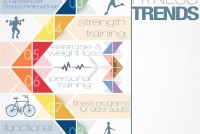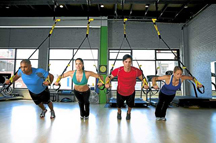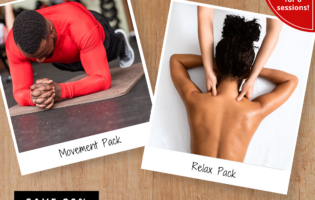Total Therapy Blog

Top Health Trends for 2014

Happy New Year! For the majority of Canadians, the New Year means a time for starting fresh and making healthy lifestyle changes. If you’re feeling a little sluggish from the holiday season’s excesses, we’re here to help! We’ve taken a look at 2014’s predicted top health trends, and analyzed them with a critical eye to help you discern fad from fact.
 According to the American College of Sport Medicine, this year’s top five trends are:
According to the American College of Sport Medicine, this year’s top five trends are:
- High-intensity interval training (HIIT)
- Body weight training
- Educated and experienced fitness professionals
- Strength training
- Exercise and weight loss.
Trend #1: High-intensity interval training
High-intensity interval training has been building in momentum for the past few years, with programs like CrossFit booming in popularity. Research studies have shown that bouts of short, high-intensity exercise can be as effective at improving your health as longer periods of lower-intensity exercise. For the time-strapped, this means the same benefits with shorter training sessions. However, high-intensity training is not for everyone and if done incorrectly can lead to injury. The majority of the research done in the area has involved highly trained college athletes who are already accustomed to working at high intensity levels. Most health professionals will tell you that if you are starting from a relatively sedentary baseline, high-intensity training is not for you. Instead, start with a moderate-intensity program with ample warm-up and cool-down periods and build gradually from there. If you’re unsure as to what is an appropriate starting point, consult with a health professional like your kinesiologist or physiotherapist to get a program customized to your current fitness level. That way, you can safely build up to a short burst, high intensity program.
 Trend #2: Body weight training
Trend #2: Body weight training
Body weight training involves using exercises that employ whole-body movements against gravity (e.g. squats, lunges, push-ups, etc.). This form of weight-training is extremely functional, as it replicates the type of movement you do every day in your life. It’s also not just for the fitness-minded – older adults or those recovering from injury can benefit from a body weight-oriented program. For example, training proper squat patterns in older adults can increase their ability to perform activities of daily living (e.g. climbing stairs, getting up out of a chair, etc.). For someone recuperating from a lower body injury (e.g. an ankle or knee sprain), squats and lunges are often incorporated into the latter portion of a rehabilitation program to promote proper biomechanics and strengthen muscles in a way that replicates the demands of a particular sport or activity.
Trend #3: Educated and experienced fitness professionals
Having a good understanding of exercise physiology and anatomy is critical to designing an effective exercise program. That’s why it’s important to work with a trained health professional. There’s a wide range of expertise among health professionals, so knowing the difference between the types of professionals will help you make the best choice for your circumstances. For example, a “Personal Trainer” may have completed a series of weekend courses followed by a written or practical exam; a “Practicing Kinesiologist” has typically completed a bachelor’s degree in kinesiology at a recognized university. If you’re looking to work with a fitness professional, some key questions to ask are:
– What sort of education background do you have?
– What type of clients do you have experience working with?
– Are there any limitations as to what type of client you can work with?
– Are there any limitations as to what you can prescribe/teach?
 Trend #4: Strength training
Trend #4: Strength training
Similar to trend #2, strength training can pay big health dividends. Strength training can prevent bone loss, boost your metabolism, improve posture, reduce the impact of osteoarthritis, and increase your functional capacity. Health Canada recommends doing activities that strengthen muscle and bone (e.g. resistance training) at least three times per week for adults. If you’re unsure where to start, having a trained fitness professional (e.g. kinesiologist or personal trainer) set-up a program for you is a great first step.
Trend #5: Exercise and weight loss
This trend is a perennial top-ten for the New Year. Living an active life and maintaining a healthy weight are good things. However, fad diets and crash exercise programs run amok every January. It’s up to you to look critically at the season’s offerings. Here are a few critical things to consider:
– Does it sound too good to be true? Beware diets or programs that promise rapid weight loss or drastic changes in body composition. A sustainable weight loss program (where you burn 500 – 1000 more calories per week than you consume) will yield a weekly weight loss of 1 – 2lbs.
– Is the program sustainable in the long-term? Healthy living is a life-long commitment – whatever healthy changes you make should be sustainable over a long period of time. Otherwise, you risk regressing back to bad habits and erasing the gains you achieved – or in extreme cases, hurting yourself through deprivation or overexertion.
– Does it pass the common-sense test? The basic principles of healthy eating and physical activity have remained relatively unchanged for the past decade. Eat a balanced diet, get in regular bouts of varied physical activity with progressive overload, and you’ll do just fine. A program that contradicts these basic ideas doesn’t pass the common-sense test. What’s more, it also likely fails the sustainability!
Whether you’re a New Year resolution person or not, it’s always a good time to start making healthy changes. You also don’t have to go it alone – friends, family members, and your health care practitioner are all here to help. So whatever your goal is, here’s wishing you good luck and a very Happy New Year!








Follow Us!
& Stay Up To Date
BLOG